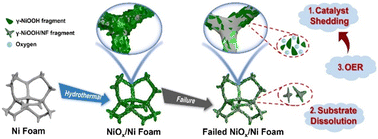Insights into the deactivation mechanism of a self-supported nickel electrode for 5-hydroxymethyl furfural electrooxidation: focus on the stability of the electrode as a whole†
Abstract
The electro-conversion of 5-hydroxymethylfurfural (HMF), an important biomass-derived building block chemical, is a promising approach to realize the utilization of biomass. Nickel foam is normally used as the substrate of self-supported electrodes for such a reaction. Although self-supported nickel oxide electrodes (NiOx/NF) show excellent electrocatalytic performance during the electrooxidation of HMF to 2,5-furanediformic acid (FDCA), there is still a lack of in-depth understanding of their stability. Herein, we investigated the performance degradation of NiOx/NF electrodes under operating conditions. The results show that the surface current distribution of the electrode is seriously uneven after electrolysis, and the electrochemically active area (ECSA) and intrinsic electrochemical performance decreased after undergoing a process of activation, resulting in deactivation ultimately. There are three possible paths for the deactivation process of NiOx/NF electrodes: (1) catalytically active layer shedding: the catalytic layer undergoes a phase change to form γ-NiOOH and the increased layer spacing leads to volume expansion and subsequent shedding. (2) Nickel matrix dissolution. (3) Oxygen evolution reaction (OER) occurring during electrolysis: oxygen bubbles accelerate the shedding of the catalytic layer, and this shedding behavior is exacerbated when the concentration polarization is high. In this paper, novel strategies are proposed to enhance the stability of NiOx/NF electrode from three aspects: the catalytic layer, the matrix, and the degree of combination of the two.



 Please wait while we load your content...
Please wait while we load your content...